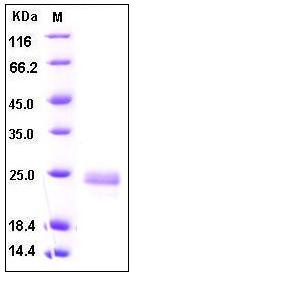Human TNFSF14 / LIGHT / CD258 Protein (His Tag)
CD258,HVEML,LIGHT,LTg,TR2
- 100ug (NPP4329) Please inquiry
| Catalog Number | P10386-H07H |
|---|---|
| Organism Species | Human |
| Host | Human Cells |
| Synonyms | CD258,HVEML,LIGHT,LTg,TR2 |
| Molecular Weight | The recombinant human TNFSF14 consists of 183 amino acids and and has a predicted molecular mass of 20.4 kDa. |
| predicted N | His |
| SDS-PAGE |  |
| Purity | > 85 % as determined by SDS-PAGE |
| Protein Construction | A DNA sequence encoding the human TNFSF14 (NP_003798.2) extracellular domain (Asp 74-Val 240) was fused with a polyhistidine-tag at the N-terminus. |
| Bio-activity | |
| Research Area | Signaling |Signal Transduction |Signaling Pathway |Representative pathway |Apoptosis Signaling pathway |Regulation of Apoptosis by TNF Superfamily Members | |
| Formulation | Lyophilized from sterile PBS, pH 7.4 1. Normally 5 % - 8 % trehalose and mannitol are added as protectants before lyophilization. Specific concentrations are included in the hardcopy of COA. |
| Background | LIGHT, also known as TNFSF14 or CD258, is a newly identified member of the TNF superfamily (TNFSF14) that is expressed by activated T lymphocytes, monocytes, granulocytes, spleen cells, and immature dendritic cells. TNFSF14 / LIGHT / CD258 is a type II transmembrane protein that is known to bind 2 membrane-bound TNFSF signaling receptors: HVEM, which is predominantly expressed by T cells, and lymphotoxin β receptor (LTβR), which is expressed by stromal cells and nonlymphoid hematopoietic cells. TNFSF14 / LIGHT / CD258 also binds to a soluble nonsignaling receptor, decoy receptor 3 (DcR3), which can modulate the function of LIGHT in vivo. TNFSF14 / LIGHT / CD258 can also costimulate T cell responses via HVEM, which is constitutively expressed in most lymphocyte subpopulations, including CD4+ and CD8+ T cells. In addition, TNFSF14 / LIGHT / CD258 has been shown to suppress tumor formation in vivo and to induce tumor cell apoptosis via the up-regulation of intercellular adhesion molecule 1 and an increased lymphocyte adhesion to cancer cells. Thus, TNFSF14 / LIGHT / CD258 is being actively investigated as a possible basis for cancer treatment. |
| Reference |
